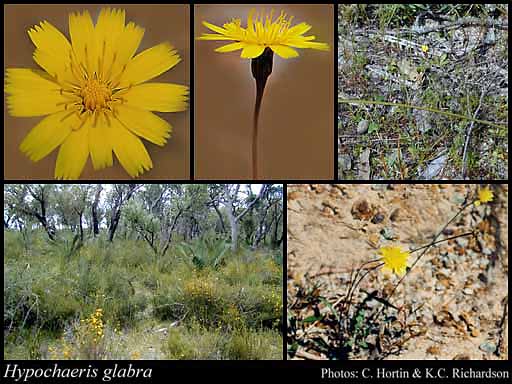- Reference
- Sp.Pl. [Linnaeus] 2:811 (1753)
- Conservation Code
- Not threatened
- Naturalised Status
- Alien to Western Australia
- Name Status
- Current
Rosetted annual or perennial, herb, 0.08-0.5 m high, leaves smooth; flower heads up to 1.5 cm across. Fl. yellow, Jan to Dec (mainly in Spring). Common weed of lawns, horticultural areas, roadsides & bushland.







Distribution
- IBRA Regions
- Avon Wheatbelt, Carnarvon, Coolgardie, Esperance Plains, Geraldton Sandplains, Jarrah Forest, Mallee, Murchison, Swan Coastal Plain, Warren, Yalgoo.
- IBRA Subregions
- Cape Range, Dandaragan Plateau, Eastern Goldfield, Eastern Mallee, Eastern Murchison, Edel, Fitzgerald, Geraldton Hills, Katanning, Lesueur Sandplain, Merredin, Northern Jarrah Forest, Perth, Recherche, Southern Cross, Southern Jarrah Forest, Tallering, Warren, Western Mallee, Western Murchison, Wooramel.
- IMCRA Regions
- Central West Coast, WA South Coast.
- Local Government Areas (LGAs)
- Albany, Armadale, Augusta Margaret River, Belmont, Beverley, Boddington, Boyup Brook, Bridgetown-Greenbushes, Bruce Rock, Busselton, Canning, Capel, Carnamah, Carnarvon, Cockburn, Collie, Coolgardie, Coorow, Cranbrook, Cuballing, Cue, Cunderdin, Dalwallinu, Dandaragan, Denmark, Donnybrook-Balingup, Dowerin, Dumbleyung, Dundas, Esperance, Exmouth, Gingin, Gnowangerup, Goomalling, Gosnells, Greater Geraldton, Harvey, Jerramungup, Kalamunda, Kalgoorlie-Boulder, Kellerberrin, Kondinin, Koorda, Kulin, Lake Grace, Mandurah, Manjimup, Menzies, Merredin, Moora, Morawa, Mount Marshall, Mukinbudin, Mundaring, Murchison, Murray, Nannup, Narrogin, Nedlands, Northam, Northampton, Perenjori, Perth, Pingelly, Plantagenet, Quairading, Ravensthorpe, Rockingham, Serpentine-Jarrahdale, Shark Bay, South Perth, Swan, Toodyay, Trayning, Victoria Plains, Wagin, Wandering, Wanneroo, Waroona, West Arthur, Wickepin, Williams, Wongan-Ballidu, Woodanilling, Wyalkatchem, Yalgoo, Yilgarn, York.
Management Notes (for the Swan NRM Region)
Alternative Names. Flat Weed, Smooth Cats-ear, Annual Flatweed.
General Biology. Growth form. Herb. Life form. Annual. Reproduction. Seed. Dispersal. Wind, animals (adhesion and occasionally ingestion). Toxicity. Toxic to horses. Fire response. Plants are usually killed, however heat stimulates germination of soil-stored seed.
Notes. Can also be biennial. Prefers Mediterranean temperate climates. Flowers all year with a flush in spring. Fruit has a feathery pappus aiding wind dispersal. Seed can remain germinable after passing through the digestive system of horses. There are several varieties and it can hybridise with Hypochaeris radicata, making identification difficult.
Additional information. Origin. Northern Africa, temperate Asia, western Asia, Europe. History of use/introduction. Fodder. Similar exotic species. Hypochaeris radicata.
Suggested method of management and control. Mowing and grazing are ineffective and often promote growth and flowering. Hand remove small infestations and/or isolated plants, ensuring the taproot is removed. Alternatively wipe rosettes with glyphosate at 30%. For dense infestations, apply Lontrel® 10 ml /10 L + wetting agent. Apply herbicide regularly to prevent seeding. Read the manufacturers' labels and material safety data sheets before using herbicides. For further information consult the Australian Pesticides and Veterinary Medicines Authority to determine the status of permits for your situation or state.
Management Calendar
| Calendar Type | Jan | Feb | Mar | Apr | May | Jun | Jul | Aug | Sep | Oct | Nov | Dec | Comments |
|---|---|---|---|---|---|---|---|---|---|---|---|---|---|
| Germination | O | Y | Y | Y | Y | ||||||||
| Active Growth | Y | Y | Y | Y | Y | Y | Y | ||||||
| Flowering | O | O | O | Y | Y | Y | Y | Y | Y | Y | Y | O | |
| Fruiting | U | U | U | U | Y | Y | Y | ||||||
| Manual Removal | Y | Y | Y | Y | Y | Y | |||||||
| Herbicide Treatment | Y | Y | Y | Y | Y |
Legend: Y = Yes, regularly, O = Occasionally, U = Uncertain, referred by others but not confirmed.
References
- Arnold, G.W., Weeldenberg, J.W. & Leone, J. (1998) Herbicide control of exotic annual plant species in Acacia acuminata - Eucalyptus loxophleba woodland in south-western Australia and effects on native ground flora. Plant Protection Quarterly, 13 (1): 39-43.
- Brown, K. & Brooks, K. (2002) Bushland Weeds: A Practical Guide to their Management. Environmental Weeds Action Network, Greenwood.
- Figueroa, J.A., Lohengrin, A.C., Gomez-Gonzalez, S., Montenegro, M. & Jaksic, F.M. (2009) Do heat and smoke increase emergence of exotic and native plants in the mattoral of central Chile. Acta Oecologica, 35: 335-340.
- Hussey, B.M.J., Keighery, G.J., Dodd, J., Lloyd, S.G. & Cousens, R.D. (2007) Western Weeds. A guide to the weeds of Western Australia. 2nd Edition. The Plant Protection Society of Western Australia, Victoria Park.
- Moore, C.B. & Moore, J.H. (2002) Herbiguide, the pesticide expert on a disk. Herbiguide, PO Box 44 Albany, Western Australia, 6330.
- Moore, J.H. & Wheeler, J. (2008) Southern weeds and their control. DAFWA Bulletin 4744.
- Swarbrick, J.T. & Skarratt, D.B. (1994) The bushweed 2 database of environmental weeds in Australia. The University of Queensland, Gatton College.
- USDA, ARS, National Genetic Resources Program (2009) Germplasm Resources Information Network - (GRIN). National Germplasm Resources Laboratory, Beltsville, Maryland. URL: https://npgsweb.ars-grin.gov/gringlobal/taxon/taxonomysimple.aspx - Accessed October 2009.